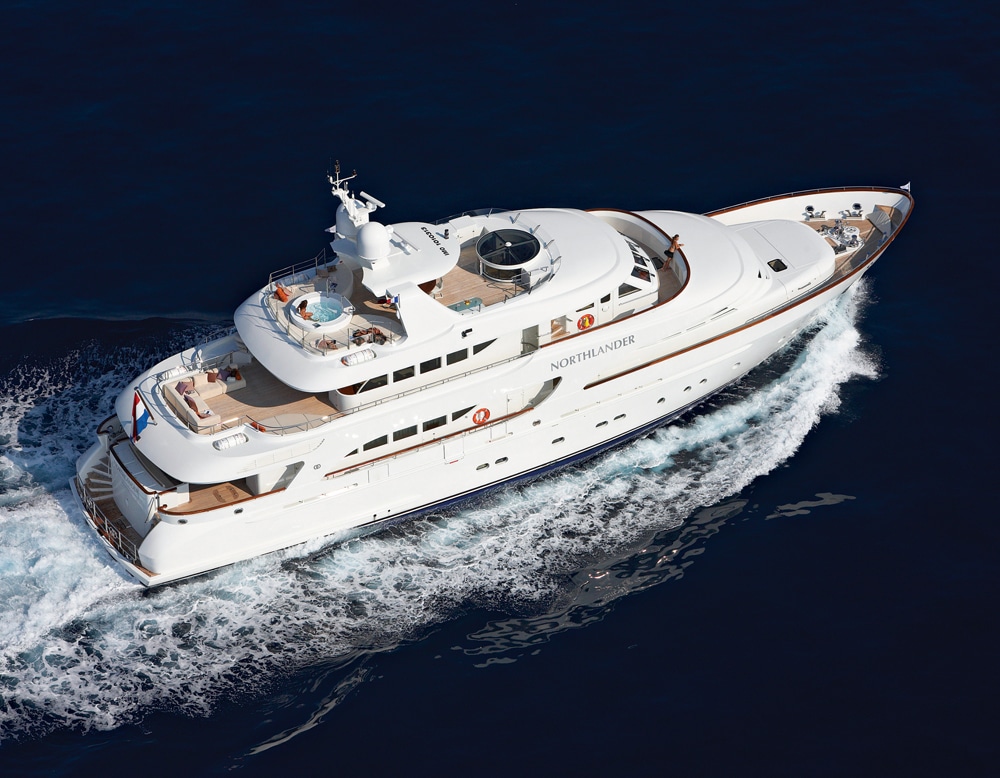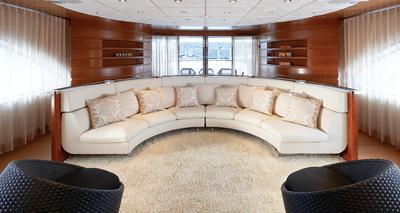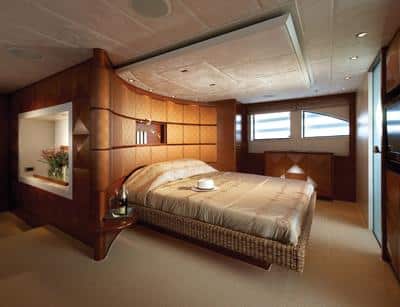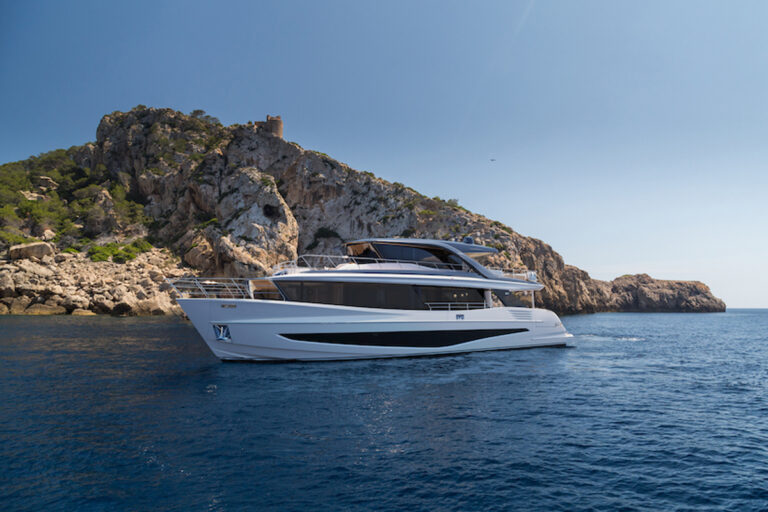
Moonen 124: Northlander
Moonen Shipyards has long been known for custom and semi-custom motoryachts that typically range from about 80 feet to 100 feet. The Dutch builder often refers to them as “pocket-sized superyachts,” and the expression is apt for the exceptional level of fit and finish accorded these vessels, given their length. But these days, pockets need to be a lot bigger—and deeper, too—since the company recently delivered its new flagship, a 124-footer christened Northlander that raises the company’s bar another notch in both size and quality.
Besides being a great new motoryacht in her own right, Northlander is a fitting showcase for the capabilities of Moonen Shipyards as they gradually begin adding larger and larger yachts to the top end of their range, business which continues on a strong basis. Recent and coming deliveries include a 99-foot, all-aluminum motoryacht which launched last year, two 97-foot steel/aluminum yachts due to be delivered this year, and a 110-foot steel/aluminum motoryacht planned for a 2012 launch. In addition, the yard completed extensive refits of two earlier Moonen yachts last year.
All of these projects are done with the same attention to detail that befits Moonen’s move up the size meter, but it was a 94-foot build from a few years ago that really changed the company’s direction. That yacht, Nilo, was the company’s first all-aluminum build of that size, and is the personal yacht of Salim Erdem, principal owner of Merit AS of Turkey, and the latest owner of Moonen Shipyards.
Speaking with Erdem and Moonen Managing Director Emile Bilterijst aboard Northlander, we discussed the company and its future. “I am the living proof of how a spirit of cooperation at Moonen can create a better product,” said Erdem. “Several years ago I chose Moonen, after visiting several other yards, to build Nilo.” Erdem told me he has “no short-term plans” to move any part of Moonen’s production to Turkey, an obvious possibility in light of the country’s well-established and growing boatbuilding industry. “I didn’t enter Moonen for just a financial investment or for profit,” Erdem said. “It is more a symptom of a passion to continue moving the shipyard forward. Yes, we are pleased with the facilities, but we are more interested in the spirit and humanity of the team and its quality.”

The team to which Erdem refers includes more than just Moonen employees. Bilterijst is a graduate naval architect who has a hand in the planning of every Moonen yacht, but he disclaims credit for their design, giving that instead to outside design consultants that change from boat to boat. For Northlander, the list included Rene van der Velden Yacht Design, Art-Line Interior Design, and Stolk Marimecs, as well as Moonen’s own engineers.
Such a diverse and changing mix obviously requires coordination, and that’s where Bilterijst shines. As a designer himself, he knows what’s involved and can keep the team members working together without having them step on each other’s toes. It’s a critical part of the process that is recognized by Erdem as a path to excellence. Making the most of the skilled players brought into a build means the result will be greater than the sum of its parts.
Like a number of Moonen Yachts before her, Northlander is a Rene van der Velden design with an interior by Art-Line, so I didn’t expect a lot of surprises, but there were a few. She displays van der Velden’s gentle signature curves in her sheer and superstructure, but owing to her extra length, she is noticeably sleeker than earlier designs.
The extra length and associated wider beam provide space, and lots of it. While Northlander uses that room to add a number of amenities not possible on Moonen’s smaller yachts, her interior is remarkably uncluttered. Side decks, generously wide even for my full frame, run the entire length of the yacht, so the saloon, dining area, and owner’s stateroom are narrower than they would be with a full-beam house. Even so, Art-Line and the owner have resisted the temptation to pack the remaining space with furnishings.

Every square inch aboard a yacht is valuable real estate, and most owners don’t want to “waste” the space by leaving it open. Northlander is different, and the result is an exceptionally serene atmosphere. A curved settee and two chairs, all on an area carpet toward the center of the saloon, create an intimate seating area conducive to conversation with friends and family. It also allows space outboard of the seating, so other guests can pass through the room without disturbing those already seated there.

Forward of the saloon, the dining area is similarly arranged, with lots of space around the centrally located table and chairs. Adjacent to the dining room, forward and to port, is a well-appointed galley that also incorporates a service area, access to the side deck, and a crew stair to the mess and crew quarters on the lower deck.
Inboard of the galley and forward of the dining area is a central foyer and spiral staircase that is stunning and, in my experience, unique in its construction. Stainless steel handrails sitting atop copper mesh panels wind their way from the lower deck to the flying bridge. There, a glass skylight admits sunshine that penetrates all the way to the guest accommodations, thanks to the mesh panels and open risers on the stairs.
Many spiral stairs, to save space, are uncomfortable, if not downright unsafe, in the tightness of their curve and the narrowness of their treads. Once again, the designer and owner have seen fit to sacrifice a bit of otherwise-usable space to make things better. There’s an open core to these stairs, so the inside end of each tread has a bit of dimension rather than coming to a point. The treads are wide, and further enhancing the feeling of security at sea, handrails are fitted at both the center and outside of the spiral, something that is too seldom done.

Additionally, most such stairs on trideck yachts like Northlander terminate at the bridgedeck and another set of stairs, usually exterior, provides access to the flying bridge. Northlander has such an exterior staircase to starboard, but there’s more with this special yacht. At the top of the interior spiral stairs, the skylight slides upward on a central column, looking much like a mushroom when it’s open. This allows the staircase to continue upward one more deck, providing direct access from the skylounge to the flying bridge. It also creates an opportunity for superb natural ventilation—a so-called chimney effect—on days when the weather and seas permit. Open the ports in the staterooms and lift the skylight, and you’ll be surprised at the pleasant breeze flowing through the entire yacht.
The owner’s stateroom, forward on the main deck, holds more surprises. Entering the room from the main foyer, a large white-painted recess inboard provides space for an objet d’art or two, and outboard, a private sitting area that, reminiscent of early sailing ships, includes a hammock slung in the corner. At the forward end of the stateroom, under the brow and down three steps, is the master bath area. Above the tub, a row of windows, translucent to obscure the view from the foredeck, bring an incredible amount of natural light into both the bath and the remainder of the stateroom.

Belowdecks, four guest staterooms are arranged around the central staircase to accommodate eight guests. The forward guest staterooms have twin berths, and the aft VIP staterooms are outfitted with queen berths. Like the owner’s stateroom, the joinerwork throughout these staterooms displays intricate geometric panels that showcase the skill and care of Moonen’s carpenters.
The engineroom lies abaft the VIP staterooms and at the stern is a large tender garage. To launch and retrieve the tender, rather than using a davit, Moonen developed and built a system they consider simpler and safer to operate. Looking much like a very luxurious boat trailer, an inclined system of rollers allows the tender to slide in and out of the water with ease.
The pilothouse has a striking design that would seem to be inspired by science fiction and wing stations for close maneuvering. Abaft the pilothouse is a spacious skylounge that includes a pantry to port. It opens through sliding glass doors to a huge open afterdeck area, partially shaded and partially under the sky. The versatility of such an arrangement is invaluable. I was aboard Northlander once during a cruise with a fairly large party. The weather offered moderate temperatures but intermittent showers. With the doors open, refreshments were being served in the skylounge and there was still plenty of room for the guests to circulate even when the rains appeared. Later, during another visit at lower latitudes with a smaller complement, Northlander was buttoned up, allowing some to take in the sun and others to beat the heat in the air-conditioned skylounge.

In light of the pilothouse nerve center, the flying bridgedeck has no upper helm and is fully devoted to guest relaxation. The exterior and spiral interior stairways take up a bit of space at the forward end, but there’s still plenty of room for any guests who want to have a look over the bow. Amidships is a large hardtop, a stylish extension of the radar arch, and under it lies a circular dining table with seating for the entire guest roster. Further aft, in the sun, is a whirlpool spa surrounded by sunpads.
Considering how Northlander used the additional space of its length and beam—by not using it, so family and guests can—the prospect of more large yachts from Moonen is interesting indeed. And designs for 130- and 148-foot expedition yachts in the pipeline mean this size adjustment may be here to stay.
LOA: 125’2″
LWL: 114’0″
Beam: 28’3″
Draft: 8’2″
Disp.: 325 tons full load
Fuel: 12,000 gal.
Water: 2,100 gal.
Holding: 1,200 gal.
Construction: Steel hull, aluminum superstructure
Design: Rene van der Velden
Interior: Art-Line
Naval Architecture: Stolk Marimecs
Generators: 2 x 89 kW Northern Lights
Stabilizers: Naiad, zerospeed type 520
Bow Thruster: Wesmar, hydraulic V2-20
Watermaker: Idromar MC5 duplex
Engines: 2 x 1,070-hp MTU 16V2000 M60 diesels
Speed: 14 knots max., 11 knots cruise at half load
Range: 5,600 nautical miles at 8 knots
Price: Upon request
Moonen Shipyards, +31 0 73 6210094; www.moonen.com









